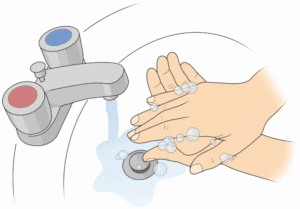
Whether or not you use catheters, it’s a good possibility you’ve experienced one of the most common types of bacterial infections in the world: urinary tract infections (UTIs). This handy guide to urinary tract infections breaks down everything you need to know, including signs and symptoms, what causes UTIs, who’s at risk, and what to do when you think you have a UTI.
The Complete Guide to UTIs (Urinary Tract Infections)
Urinary tract infections occur when bacteria enter the urethra (the tube that leads from the bladder to the exterior of the body through which urine travels). This is a fairly common kind of infection. According to the Cleveland Clinic, around 8 million to 10 million people are treated yearly for UTIs.
Who’s at Risk for Getting UTIs
Urinary tract infections can happen to anyone, but women are almost twice as likely as men to contract a UTI. Additionally, people with spinal cord injuries (SCI) also experience a higher risk of UTIs. People who use catheters may also be at risk of catheter-associated urinary tract infections, also known as CAUTIs.
Even if you’ve been lucky enough to avoid UTIs so far, you should stay updated about symptoms, treatment options, and UTI prevention tips.
What Are the Signs of a UTI or CAUTI?
The signs of a UTI may vary from one person to another, but the most common sign of a UTI is a burning sensation when you pee or an increased urge to urinate. Some people may notice that they have specks of blood or matter in their urine, while others may see only slight cloudiness. People with UTIs can also have varying levels of fever from mild to intense.
Here are some common symptoms of UTIs:
- Burning sensation or pain in the lower abdomen
- Low-grade to high fever
- Cloudy or bloody urine
- Fatigue
- Chills
- Frequent urge to urinate with little urine output
Some people may exhibit all of these symptoms, only a few, or none at all. In particular, people with a spinal cord injury or those who are paralyzed may not even notice symptoms like pain or burning until the infection is more advanced, causing fever and chills.
At the first sign of an infection, get in to see your doctor for diagnosis and quick treatment.

What Causes UTIs?
UTIs occur when bacteria enter through the urethral opening and travel up the urinary tract. This may happen during the insertion and removal of intermittent catheters.
Unhygienic or non-sterile catheterization practices, like washing and reusing your catheters, may increase the risk of urinary tract infections and bladder infections.
Other common causes include sexual activity, poor body hygiene, or holding urine in for too long. Some people report an increase in UTIs if they frequently take bubble baths or use certain body care products.
Can a UTI Turn into Something More Serious?
Yes. To be clear, most UTIs are more or less harmless if they are caught and treated quickly. However, when left untreated, a UTI can travel up the urinary system into the bladder, causing a bladder infection (cystitis), or even reach the kidneys. A kidney infection can be life-threatening in severe cases, so be sure to see a healthcare professional for diagnosis and treatment as soon as you notice any signs of a UTI.
Are There Catheters That Can Reduce the Risk of UTIs?
Yes! Many catheter manufacturers today are focusing on ways to keep the catheterization process hygienic and touch-free, reducing the risk of contracting infections.
Talk to our specialists about your catheter options and request samples today!
UTI Diagnosis and Treatment Options
Are UTIs treatable? Yes! As said above, your best chance of beating your urinary tract infection is by seeing a prescribing healthcare professional as soon as possible. In the meantime, keep drinking plenty of water to help flush the bacteria concentrations out.
First, your physician will want to accurately diagnose the issue. Typically, this is done with a quick urine sample test, known as a urinalysis. Plus, your doctor will also likely want to do a full lab analysis with a urine culture test to determine what type of bacteria is causing the infection. This helps them narrow down the medication options that will work best in your case.
Regarding treatment, a round of antibiotics is the first and often best option. Often, this is enough to knock out your UTI.
However, for those who experience recurrent UTIs frequently, your doctor may look at alternate options. Severe infections may call for hospitalization, so it’s always best to seek treatment as soon as you think you have a UTI.
As you recover from your UTI, your doctor may recommend using a heating pad to relieve any abdominal pain. In the meantime, you may also want to up your water intake to help flush bacteria out.
How to Prevent UTIs
Even the most cautious people can still sometimes contract UTIs. However, you always have options to take preventative steps and potentially reduce the risks.
According to Harvard Health Publishing, you may be able to help prevent UTIs better by staying hydrated with plenty of water and voiding your bladder throughout the day. This helps flush out bacteria trying to grow. Supplementing your diet with cranberries or cranberry extract, Vitamin C, and probiotics may help as well.
It’s a good idea to practice sterile intermittent catheterization (using each catheter once and then throwing it away) instead of washing and reusing your catheters.
Here are a few helpful tips for preventing catheter-associated UTIs:
1. Practice proper hygiene.
 First, the most important preventative measure is sterilizing your hands prior to handling your catheter. Some people prefer to wash thoroughly with hot water and soap, while others prefer an alcohol-based hand rub. Adding sterile gloves to your cathing regimen is an extra safety measure that may help prevent any contamination of your catheter before insertion.
First, the most important preventative measure is sterilizing your hands prior to handling your catheter. Some people prefer to wash thoroughly with hot water and soap, while others prefer an alcohol-based hand rub. Adding sterile gloves to your cathing regimen is an extra safety measure that may help prevent any contamination of your catheter before insertion.
In addition, you may want to clean the area around the insertion point with an antibacterial solution, such as BZK (benzalkonium chloride) wipes or povidone-iodine swabs. This helps cut the concentrations of bacteria just outside the urethra.
2. Minimize urethral friction.
Your urethra has delicate tissue that can be easily irritated. Not using enough lubrication when you cath can cause friction and even injury to your urethral tissue. If you use a straight uncoated catheter, use sterile lubricating jelly packets included with your order for individual use. Each packet usually contains 3 to 5 grams of sterile lubrication that can help your intermittent catheter pass more smoothly.
You may also want to consider a type of catheter that is pre-lubricated or has a hydrophilic coating bonded to the catheter so it stays smooth and slippery throughout catheterization.
3. Evaluate the type of catheter you use.
For example, advanced catheter products like closed system catheter kits are designed to better reduce the risk of UTIs and CAUTIs. Most closed systems feature a pre-lubricated introducer tip that assists the tube in bypassing the highest concentrations of bacteria in the first few millimeters of the urethra. Plus, this catheter type is an all-in-one system that keeps you protected from potential hand contamination.
Most hydrophilic and pre-lubricated catheters will also feature an insertion sleeve to help you handle your catheter without directly touching the tube, which reduces hand contamination to your catheter.
Where to Get Catheter Supplies
With over twenty years of experience in helping people across the country find the catheter that works best for their needs, 180 Medical is here for you. Our customers trust us for our reliable service, discreet and fast shipments, our incredibly wide range of high-quality catheters from top brands, and our compassionate care that comes from the heart.
Whether you want to see if your insurance covers advanced products or you want to try a free sample to see what works best for you, our Catheter Specialists are ready to help! Get started by filling out the contact form to the right or accessing our online Live Chat.
Disclaimer: Please note that this is intended to provide a general understanding of UTIs. It is not medical advice, and it should not be used in place of a visit, call, or consultation with a qualified healthcare provider.
